Initial Field Testing Results from Building-Integrated Solar Energy Harvesting Windows Installation in Perth, Australia
Abstract
Featured Application
Abstract
1. Introduction
2. System Design Features, Methodologies of Energy Harvesting Performance Assessment, and Principal Results
2.1. System Configuration Features and Preliminary Modeling Results
2.2. Detailed System Performance Observations, Evaluation, and Analysis
3. Discussion and Assessment of Future Application Areas
4. Conclusions
Supplementary Materials
Author Contributions
Funding
Acknowledgments
Conflicts of Interest
References
- Global Building Integrated Photovoltaics (BIPV) Market to Witness a CAGR of 23.4% during 2018–2024. Available online: https://www.bloomberg.com/press-releases/2019-04-25/global-building-integrated-photovoltaics-bipv-market-to-witness-a-cagr-of-23-4-during-2018-2024 (accessed on 23 July 2019).
- Capuano, L. International Energy Outlook 2018 (IEO2018); US Energy Information Administration: Washington, DC, USA, 2018. [Google Scholar]
- Hoffert, M.I.; Caldeira, K.; Benford, G.; Criswell, D.R.; Green, C.; Herzog, H.; Jain, A.K.; Kheshgi, H.S.; Lackner, K.S.; Lewis, J.S.; et al. Advanced technology paths to global climate stability: Energy for a greenhouse planet. Science 2002, 298, 981. [Google Scholar] [CrossRef] [PubMed]
- Chu, S.; Majumdar, A. Opportunities and challenges for a sustainable energy future. Nature 2012, 488, 294–303. [Google Scholar] [CrossRef] [PubMed]
- Hernandez, R.R.; Armstrong, A.; Burney, J.; Ryan, G.; Moore-O’Leary, K.; Diédhiou, I.; Grodsky, S.M.; Saul-Gershenz, L.; Davis, R.; Macknick, J.; et al. Techno–ecological synergies of solar energy for global sustainability. Nat. Sustain. 2019, 2, 560–568. [Google Scholar] [CrossRef]
- 20 Overlooked Benefits of Distributed Solar Energy. Available online: https://techxplore.com/news/2019-07-overlooked-benefits-solar-energy.html (accessed on 26 July 2019).
- Wang, W.; Shi, Y.; Zhang, C.; Hong, S.; Shi, L.; Chang, J.; Li, R.; Jin, Y.; Ong, C.; Zhuo, S.; et al. Simultaneous production of fresh water and electricity via multistage solar photovoltaic membrane distillation. Nat. Commun. 2019, 10, 3012. [Google Scholar] [CrossRef] [PubMed]
- Ravyts, S.; Dalla Vecchia, M.; Van den Broeck, G.; Driesen, J. Review on Building-Integrated Photovoltaics Electrical System Requirements and Module-Integrated Converter Recommendations. Energies 2019, 12, 1532. [Google Scholar] [CrossRef]
- Attoye, D.E.; Aoul, K.A.T.; Hassan, A. A Review on Building Integrated Photovoltaic Façade Customization Potentials. Sustainability 2017, 9, 2287. [Google Scholar] [CrossRef]
- Rezaei, S.D.; Shannigrahi, S.; Ramakrishna, S. A review of conventional, advanced, and smart glazing technologies and materials for improving indoor environment. Sol. Energy Mater. Sol. Cells 2017, 159, 26–51. [Google Scholar] [CrossRef]
- Barman, S.; Chowdhury, A.; Mathur, S.; Mathur, J. Assessment of the efficiency of window integrated CdTe based semitransparent photovoltaic module. Sustain. Cities Soc. 2018, 37, 250–262. [Google Scholar] [CrossRef]
- Balin, I.; Garmider, V.; Long, Y.; Abdulhalim, I. Training artificial neural network for optimization of nanostructured VO2-based smart window performance. Opt. Express 2019, 27, A1030–A1040. [Google Scholar] [CrossRef]
- United States Environmental Protection Agency. Distributed Generation of Electricity and Its Environmental Impacts; United States Environmental Protection Agency: Washington, DC, USA, 2018. Available online: https://www.epa.gov/energy/distributed-generation-electricity-and-its-environmental-impacts (accessed on 15 July 2019).
- Ramalingam, K.; Indulkar, C. Distributed Generation Systems-Design, Operation and Grid Integration, Chapter 3-Solar Energy and Photovoltaic Technology; Butterworth Heinemann: Oxford, UK, 2017; pp. 69–147. [Google Scholar]
- Gao, D.W. Energy Storage for Sustainable Microgrid; Academic Press: Cambridge, MA, USA, 2015; ISBN 978-0-12-803374-6. [Google Scholar]
- Online Video Presentation by Arup Group and Clearvue Technologies Ltd. 2019. Available online: http://www.clearvuepv.com/wp-content/uploads/2019/05/Arup-ClearVue-Smart-Facade-v2-900x506.mp4 (accessed on 26 July 2019).
- Biyik, E.; Araz, M.; Hepbasli, A.; Shahrestani, M.; Yao, R.; Shao, L.; Essah, E.; Oliveira, A.C.; del Caño, T.; Rico, E.; et al. A key review of building integrated photovoltaic (BIPV) systems. Eng. Sci. Technol. Int. J. 2017, 20, 833–858. [Google Scholar] [CrossRef]
- Cornaro, C.; Basciano, G.; Puggioni, V.A.; Pierro, M. Energy Saving Assessment of Semi-Transparent Photovoltaic Modules Integrated into NZEB. Buildings 2017, 7, 9. [Google Scholar] [CrossRef]
- Husain, A.A.F.; Hasan, W.Z.W.; Shafie, S.; Hamidon, M.N.; Pandey, S.S. A review of transparent solar photovoltaic technologies. Renew. Sustain. Energy Rev. 2018, 94, 779–791. [Google Scholar] [CrossRef]
- Vasiliev, M.; Nur-E-Alam, M.; Alameh, K. Recent Developments in Solar Energy-Harvesting Technologies for Building Integration and Distributed Energy Generation. Energies 2019, 12, 1080. [Google Scholar] [CrossRef]
- Dalapati, G.K.; Kushwaha, A.K.; Sharma, M.; Suresh, V.; Shannigrahi, S.; Zhuk, S.; Masudy-Panah, S. Transparent heat regulating (THR) materials and coatings for energy saving window applications: Impact of materials design, micro-structural, and interface quality on the THR performance. Prog. Mater. Sci. 2018, 95, 42–131. [Google Scholar] [CrossRef]
- Vasiliev, M.; Alameh, K.; Nur-E-Alam, M. Spectrally-Selective Energy-Harvesting Solar Windows for Public Infrastructure Applications. Appl. Sci. 2018, 8, 849. [Google Scholar] [CrossRef]
- Alghamedi, R.; Vasiliev, M.; Nur-E-Alam, M.; Alameh, K. Spectrally-Selective All-Inorganic Scattering Luminophores For Solar Energy-Harvesting Clear Glass Windows. Sci. Rep. 2014, 4, 6632. [Google Scholar] [CrossRef]
- Vasiliev, M.; Alghamedi, R.; Nur-E-Alam, M.; Alameh, K. Photonic microstructures for energy-generating clear glass and net-zero energy buildings. Sci. Rep. 2016, 6, 31831. [Google Scholar] [CrossRef]
- Rosenberg, V.; Vasiliev, M.; Alameh, K. A Spectrally Selective Luminescence Concentrator Panel with a Photovoltaic Cell. EP Patent No. 2 726 920 B1, 23 August 2017. [Google Scholar]
- Vasiliev, M.; Alameh, K.; Rosenberg, V. A Device for Generating Electric Energy. U.S. Patent No. 20160204297A1, 14 July 2016. [Google Scholar]
- Goetzberger, A.; Greube, W. Solar-energy conversion with fluorescent collectors. Appl. Phys. 1977, 14, 123–139. [Google Scholar] [CrossRef]
- Debije, M.G.; Verbunt, P.P.C. Thirty Years of Luminescent Solar Concentrator Research: Solar Energy for the Built Environment. Adv. Energy Mater. 2012, 2, 12–35. [Google Scholar] [CrossRef]
- Mazzaro, R.; Vomiero, A. The Renaissance of Luminescent Solar Concentrators: The Role of Inorganic Nanomaterials. Adv. Energy Mater. 2018, 1801903. [Google Scholar] [CrossRef]
- Liu, H.; Li, S.; Chen, W.; Wang, D.; Li, C.; Wu, D.; Hao, J.; Zhou, Z.; Wang, X.; Wang, K. Scattering enhanced quantum dots based luminescent solar concentrators by silica microparticles. Sol. Energy Mater. Sol. Cells 2018, 179, 380–385. [Google Scholar] [CrossRef]
- Monthly Weather Forecast and Climate in Perth, Australia. Available online: https://www.weather-atlas.com/en/australia/perth-climate#uv_index (accessed on 31 July 2019).
- Global-First Trial of a Clear Solar Glass Structure at Vicinity Centres; Shopping Centre News: Sydney, Australia, 2019. Available online: https://www.shoppingcentrenews.com.au/shopping-centre-news/industry-news/global-first-trial-of-a-clear-solar-glass-structure-at-vicinity-centres/ (accessed on 24 September 2019).
- Vicinity Centres Publication. Vicinity to Reach Net Zero Carbon Emissions by 2030. Available online: https://www.vicinity.com.au/media-centre/media-and-news/190807_net-zero-carbon-emissions-by-2030 (accessed on 26 July 2019).
- Vicinity Centres and Mirvac Celebrated for Sustainability Achievements; The Fifth Estate: Sydney, Australia, 2019. Available online: https://www.thefifthestate.com.au/events-tfeevents/awards-event-news/vicinity-centres-and-mirvac-celebrated-for-sustainability-achievements/ (accessed on 24 September 2019).
- Gao, L.; Dougal, R.A.; Liu, S.; Iotova, A.P. Parallel-connected solar PV system to address partial and rapidly fluctuating shadow conditions. IEEE Trans. Indust. Electron. 2009, 56, 1548–1556. [Google Scholar]
- Wanneroo Weather Station. Live Internet Broadcasts of the Local Weather-Related Data; Wanneroo Weather Station: Wanneroo, Western Australia, 2019. Available online: https://weather.agric.wa.gov.au/station/WN (accessed on 1 August 2019).
- SunCalc.org Solar Astronomy Online Data Calculator. Available online: https://www.suncalc.org/#/-31.9452,115.8816,15/2019.06.01/14:34/1/3 (accessed on 1 August 2019).
- Imteaz, M.A.; Ahsan, A. Solar panels: Real efficiencies, potential productions and payback periods for major Australian cities. Sust. Energy Technol. Assessm. 2018, 25, 119–125. [Google Scholar] [CrossRef]
- Maghami, M.R.; Hizam, H.; Gomes, C.; Radzi, M.A.; Rezadad, M.I.; Hajighorbani, S. Power loss due to soiling on solar panel: A review. Ren. Sust. Energy Rev. 2016, 59, 1307–1316. [Google Scholar] [CrossRef]
- Mousazadeh, H.; Keyhani, A.; Javadi, A.; Hossein Mobli, H.; Abrinia, K.; Sharifi, A. A review of principle and sun-tracking methods for maximizing solar systems output. Ren. Sust. Energy Rev. 2009, 13, 1800–1818. [Google Scholar] [CrossRef]
- Meggers, F.; Aviv, D.; Charpentier, V.; Teitelbaum, E.; Ainslie, A.; Adriaenssens, S. Co-optimization of solar tracking for shading and photovoltaic energy conversion. In Proceedings of the 15th IBPSA Conference, San Francisco, CA, USA, 7–9 August 2017; pp. 2224–2231. [Google Scholar] [CrossRef]
- Nfaoui, M.; El-Hami, K. Extracting the maximum energy from solar panels. Energy Rep. 2018, 4, 536–545. [Google Scholar] [CrossRef]
- Zhang, T. What’s a Good Value for kWh/kWp? An Overview of Specific Yield; Solar Power World: Cleveland, OH, USA, 2017; Available online: https://www.solarpowerworldonline.com/2017/08/specific-yield-overview/ (accessed on 5 August 2019).
- Solar Calculator Ltd. Photovoltaic Output of Solar Panels; Solar Calculator Ltd.: Melbourne, VIC, Australia, 2018; Available online: https://solarcalculator.com.au/solar-panel-output/ (accessed on 5 August 2019).
- Australian Solar Radiation Figures, Data Reproduced from the Australian Solar Radiation Handbook; Energy Research and Development Corporation: Nimbin, NSW, Australia, 1995. Available online: https://www.rpc.com.au/pdf/Solar_Radiation_Figures.pdf (accessed on 6 August 2019).
- COMFEN5 Software; Berkeley Lab: Berkeley, CA, USA, 2019. Available online: https://windows.lbl.gov/software/comfen (accessed on 24 September 2019).
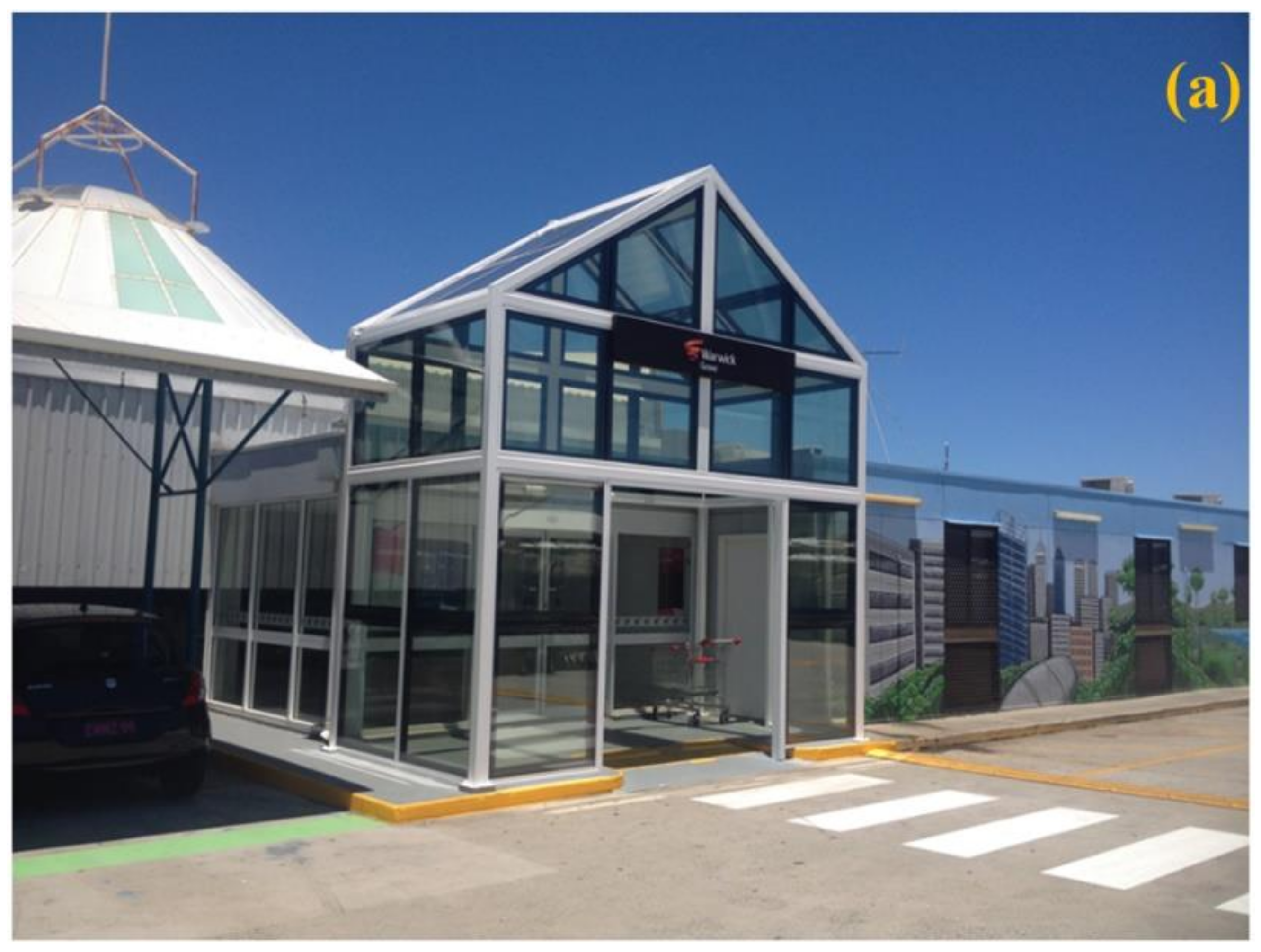
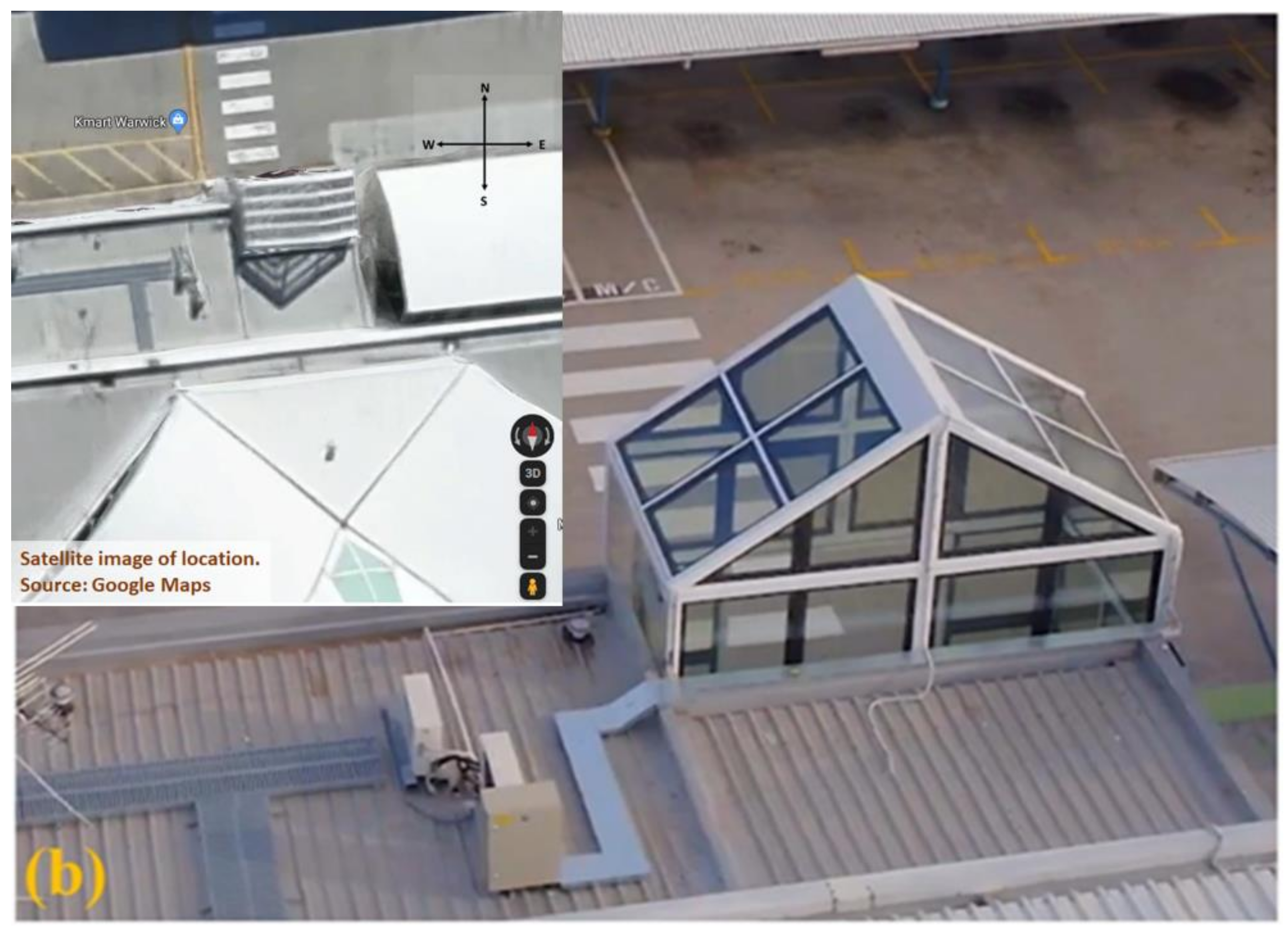
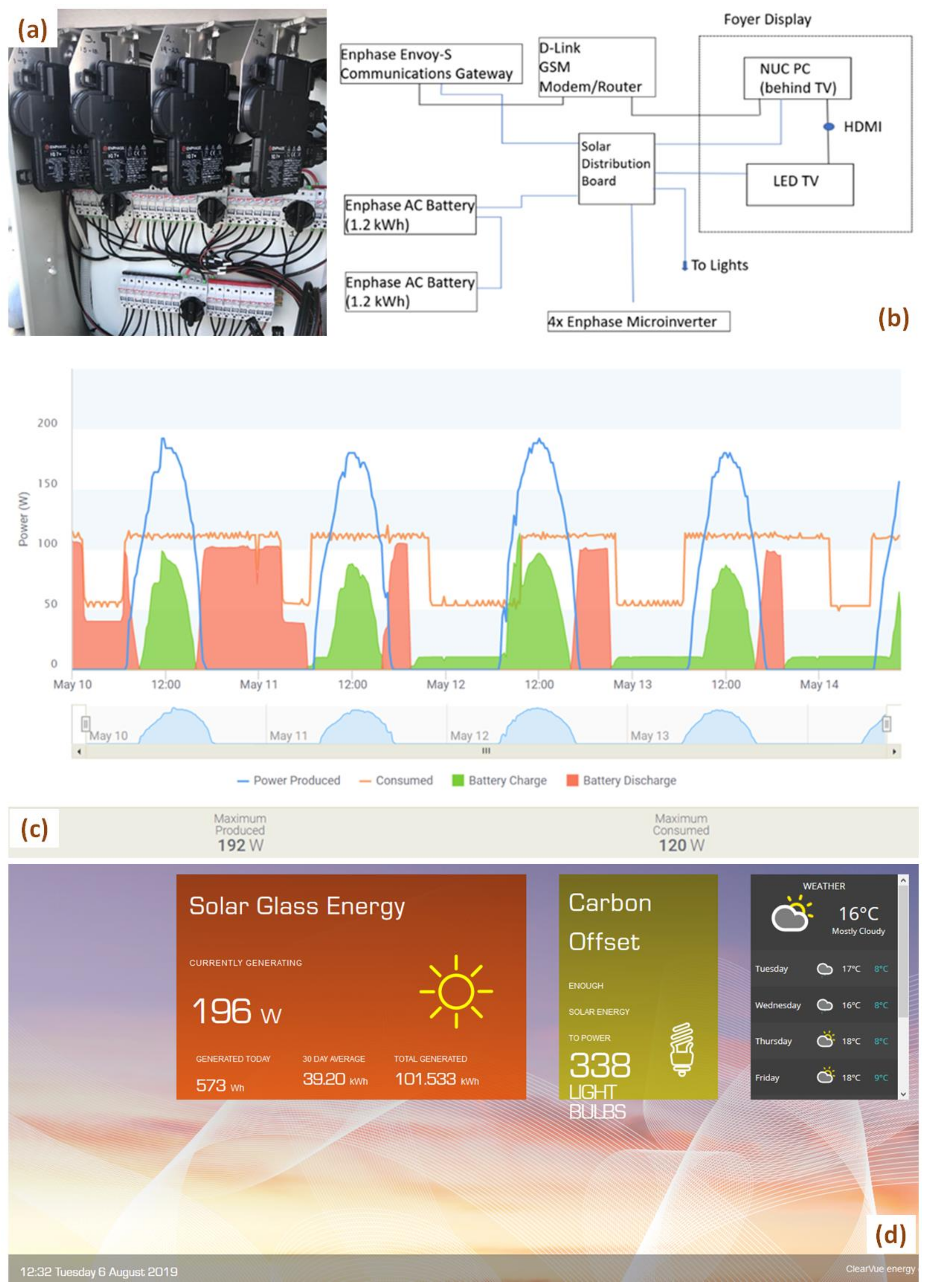
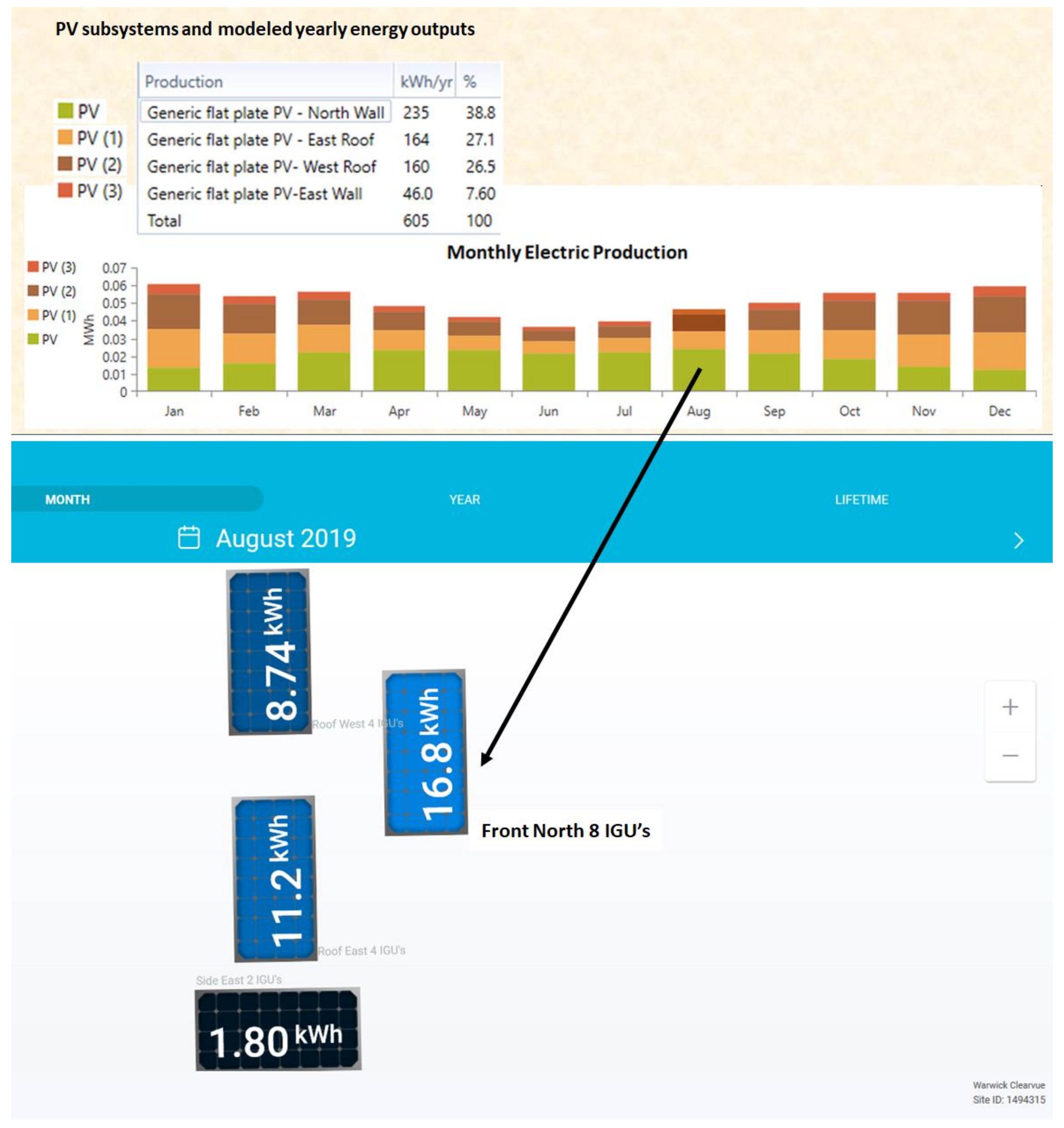
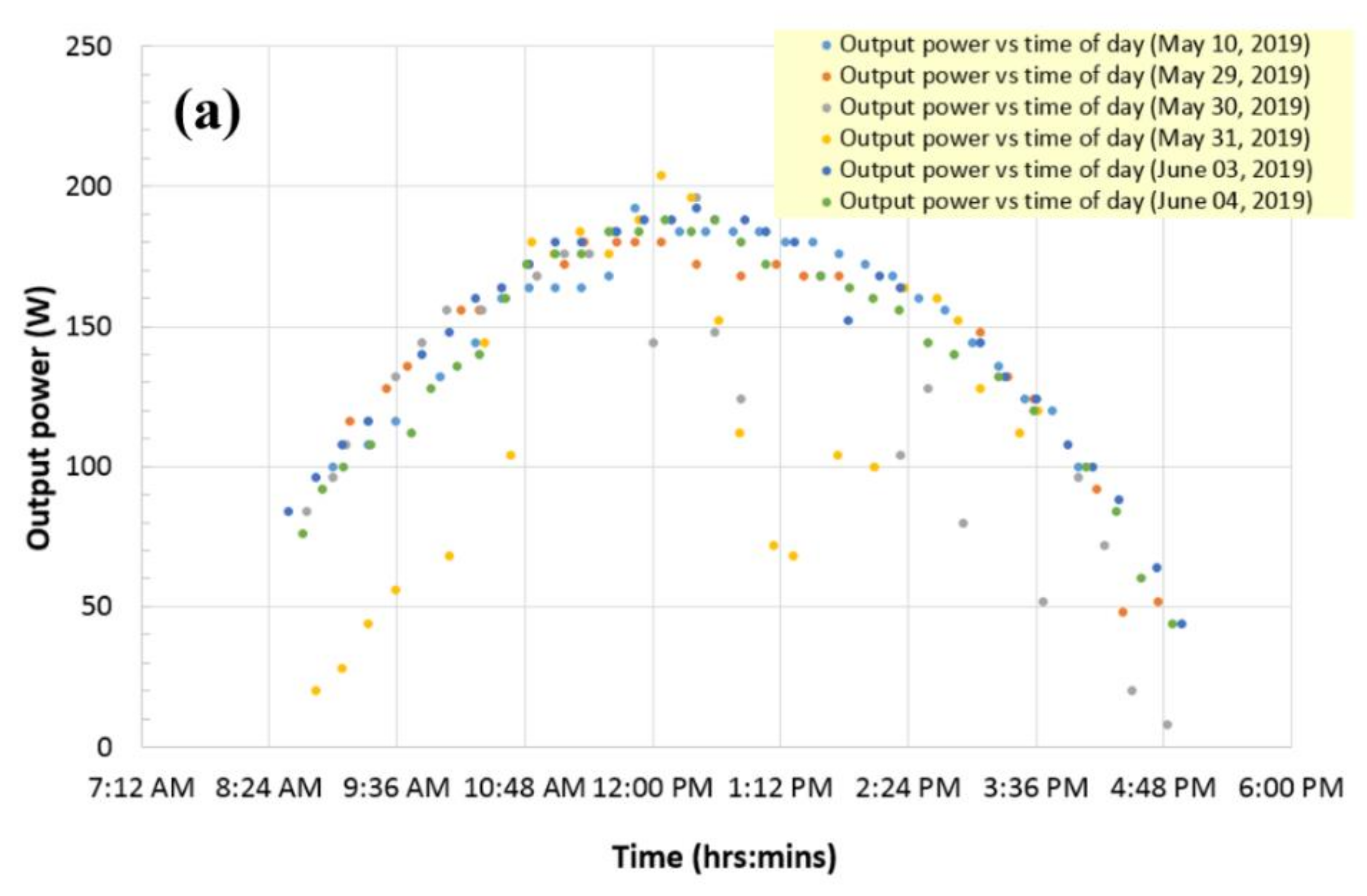
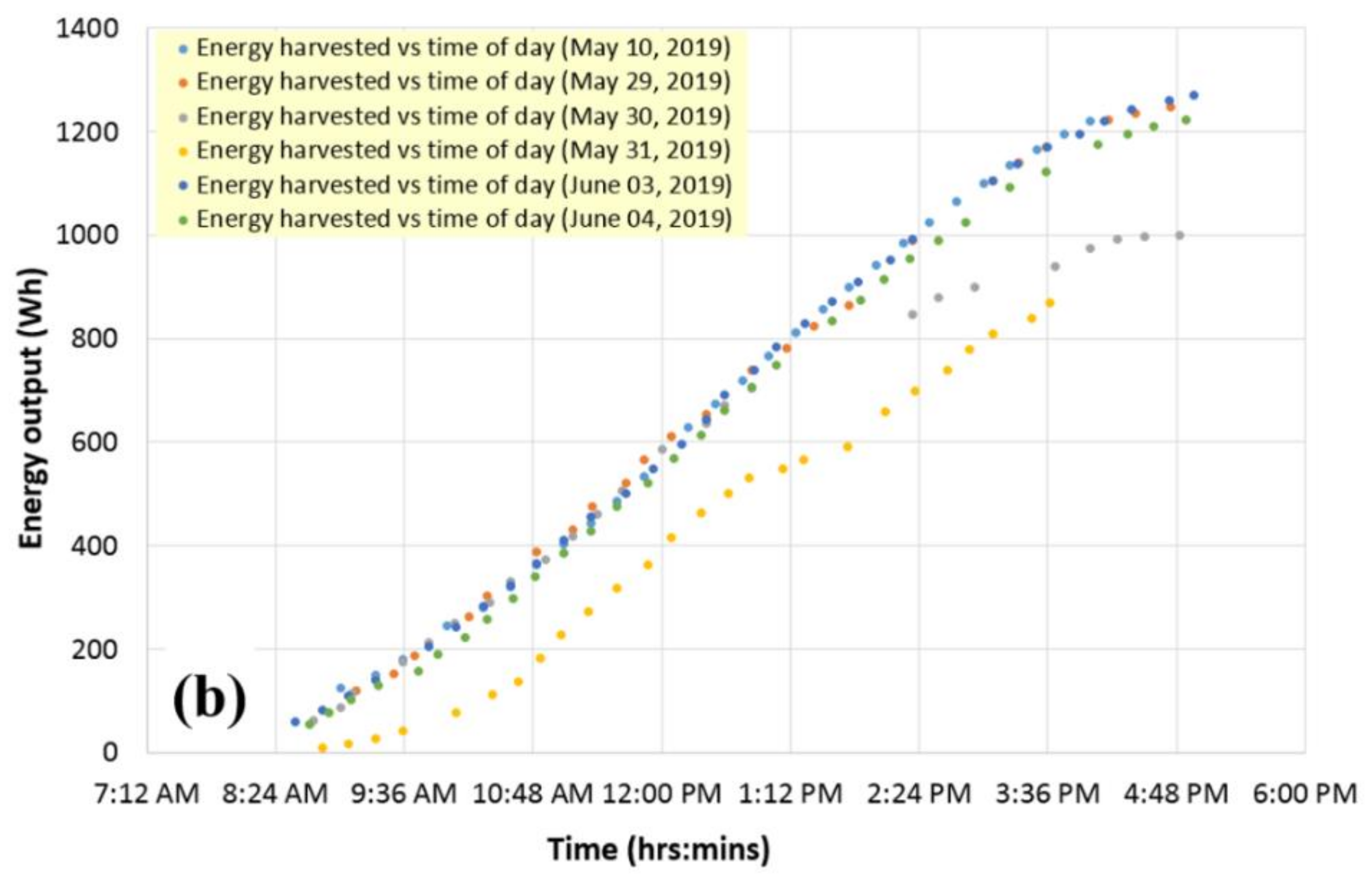
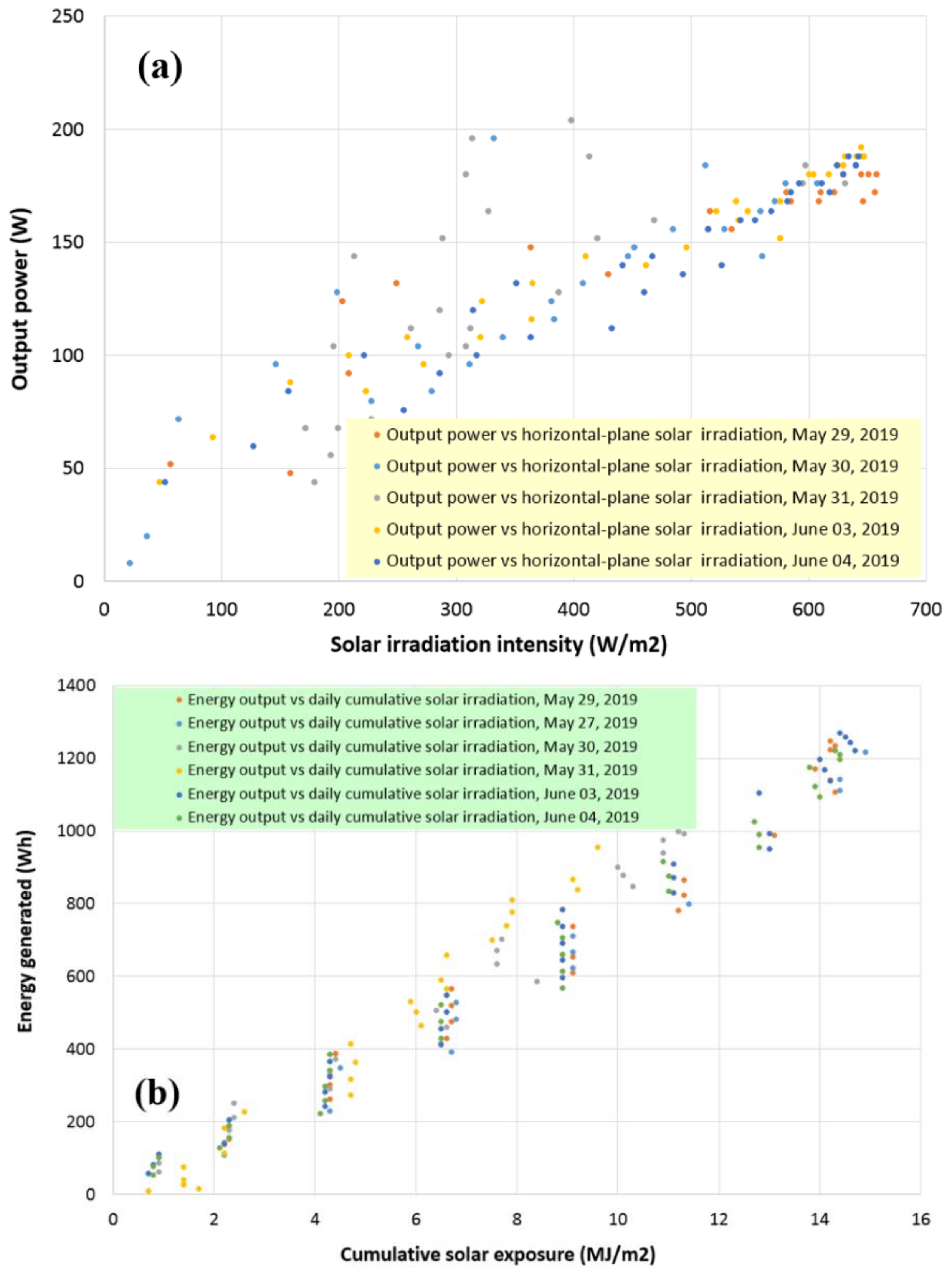
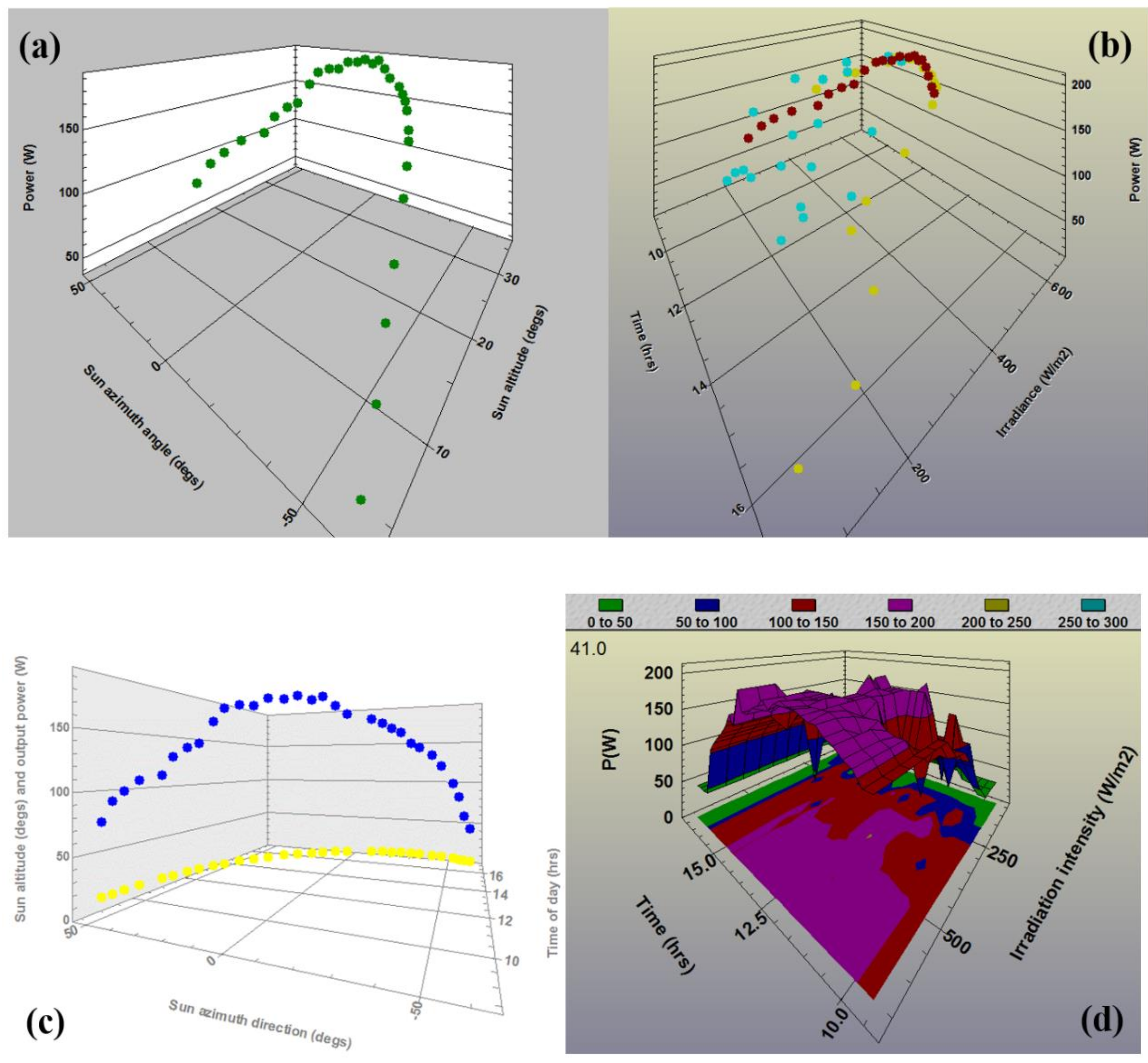
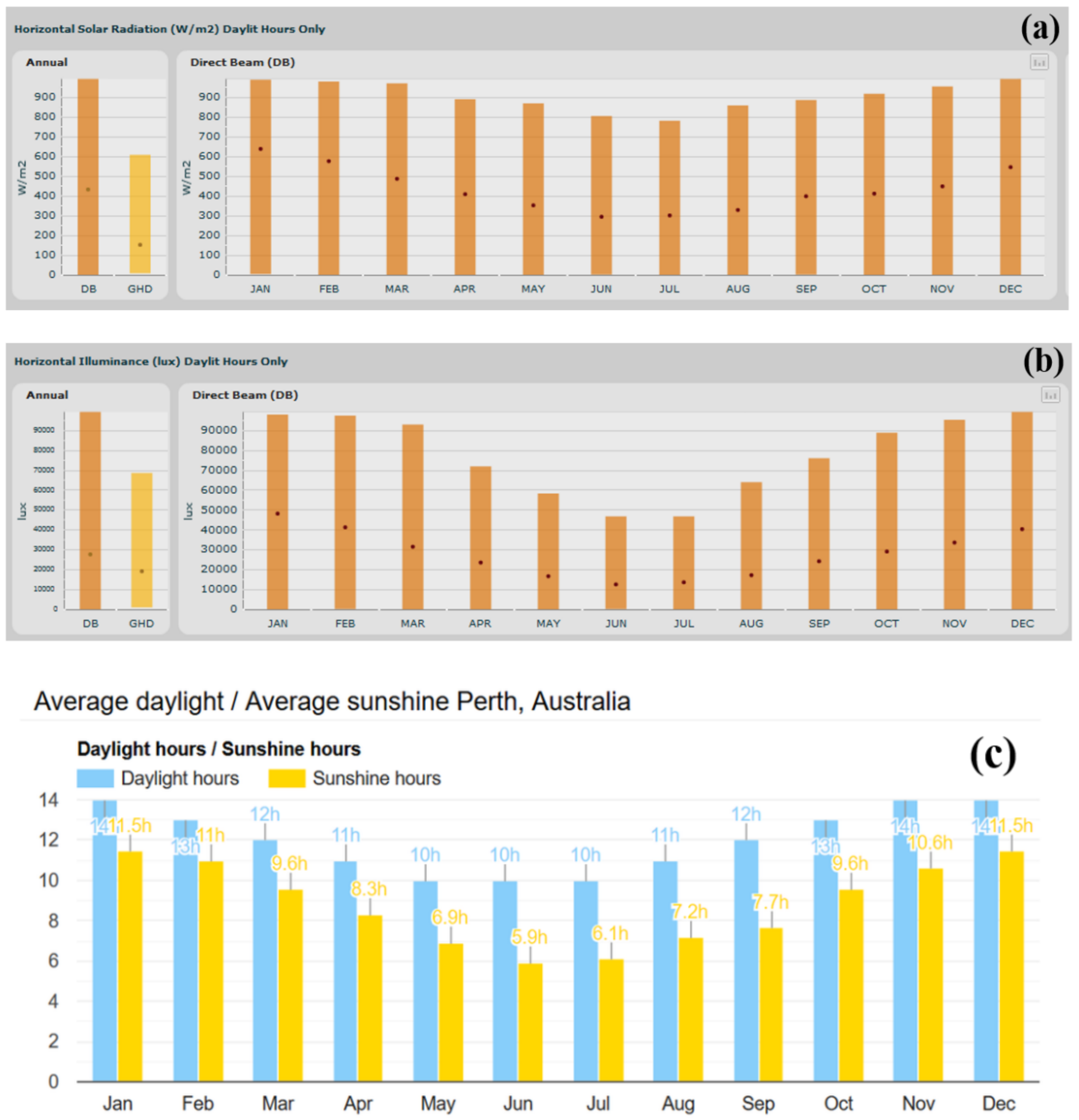
| Time | Energy stored (Wh) | Power (W) | Solar exposure (MJ/m2) | Horiz. Irradiance (W/m2) | Sun Altitude (degs) | Sun Azimuth (degs) |
|---|---|---|---|---|---|---|
| 8:43 | 54 | 76 | 0.8 | 255 | 15.8 | 50.09 |
| 8:54 | 77 | 92 | 0.8 | 286 | 17.56 | 48.17 |
| 9:06 | 102 | 100 | 0.9 | 317 | 19.41 | 46.01 |
| 9:21 | 129 | 108 | 2.1 | 363 | 21.64 | 43.18 |
| 9:44 | 157 | 112 | 2.3 | 432 | 24.83 | 38.55 |
| 9:55 | 189 | 128 | 2.3 | 460 | 26.24 | 36.21 |
| 10:10 | 223 | 136 | 4.1 | 493 | 28.04 | 32.88 |
| 10:22 | 258 | 140 | 4.2 | 526 | 29.37 | 30.11 |
| 10:37 | 298 | 160 | 4.2 | 554 | 30.88 | 26.5 |
| 10:49 | 341 | 172 | 4.3 | 585 | 31.95 | 23.51 |
| 11:05 | 385 | 176 | 4.3 | 592 | 33.19 | 19.37 |
| 11:20 | 429 | 176 | 6.5 | 611 | 34.14 | 15.37 |
| 11:35 | 475 | 184 | 6.5 | 624 | 34.87 | 11.25 |
| 11:52 | 521 | 184 | 6.5 | 640 | 35.42 | 6.5 |
| 12:07 | 568 | 188 | 8.9 | 642 | 35.67 | 2.25 |
| 12:22 | 614 | 184 | 8.9 | 640 | 35.67 | 357.98 |
| 12:35 | 661 | 188 | 8.9 | 634 | 35.48 | 354.3 |
| 12:50 | 706 | 180 | 8.9 | 629 | 35.05 | 350.08 |
| 13:04 | 749 | 172 | 8.8 | 618 | 34.44 | 346.22 |
| 13:35 | 834 | 168 | 11 | 582 | 32.42 | 337.98 |
| 13:51 | 875 | 164 | 11 | 568 | 31.03 | 333.95 |
| 14:04 | 915 | 160 | 10.9 | 542 | 29.76 | 330.8 |
| 14:19 | 954 | 156 | 12.8 | 514 | 28.12 | 327.31 |
| 14:35 | 990 | 144 | 12.8 | 467 | 26.2 | 323.76 |
| 14:50 | 1025 | 140 | 12.7 | 441 | 24.25 | 320.6 |
| 15:15 | 1093 | 132 | 14 | 351 | 20.71 | 315.66 |
| 15:35 | 1123 | 120 | 13.9 | 314 | 17.66 | 311.99 |
| 16:04 | 1175 | 100 | 13.8 | 221 | 12.93 | 307.09 |
| 16:21 | 1196 | 84 | 14.4 | 157 | 10.02 | 304.42 |
| 16:35 | 1211 | 60 | 14.4 | 127 | 7.57 | 302.32 |
| 16:53 | 1222 | 44 | 14.3 | 52 | 4.36 | 299.74 |
© 2019 by the authors. Licensee MDPI, Basel, Switzerland. This article is an open access article distributed under the terms and conditions of the Creative Commons Attribution (CC BY) license (http://creativecommons.org/licenses/by/4.0/).
Share and Cite
Vasiliev, M.; Nur-E-Alam, M.; Alameh, K. Initial Field Testing Results from Building-Integrated Solar Energy Harvesting Windows Installation in Perth, Australia. Appl. Sci. 2019, 9, 4002. https://doi.org/10.3390/app9194002
Vasiliev M, Nur-E-Alam M, Alameh K. Initial Field Testing Results from Building-Integrated Solar Energy Harvesting Windows Installation in Perth, Australia. Applied Sciences. 2019; 9(19):4002. https://doi.org/10.3390/app9194002
Chicago/Turabian StyleVasiliev, Mikhail, Mohammad Nur-E-Alam, and Kamal Alameh. 2019. "Initial Field Testing Results from Building-Integrated Solar Energy Harvesting Windows Installation in Perth, Australia" Applied Sciences 9, no. 19: 4002. https://doi.org/10.3390/app9194002
APA StyleVasiliev, M., Nur-E-Alam, M., & Alameh, K. (2019). Initial Field Testing Results from Building-Integrated Solar Energy Harvesting Windows Installation in Perth, Australia. Applied Sciences, 9(19), 4002. https://doi.org/10.3390/app9194002







